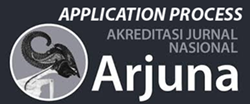Uji Kualitatif Kandungan Methanyl Yellow Pada Manisan Buah Yang Beredar di Mamuju
DOI:
https://doi.org/10.59653/jimat.v2i01.407Keywords:
Candied, Fruit, Methanyl Yellow, MamujuAbstract
Methanyl yellow is a synthetic dye, in the form of a brownish yellow powder, soluble in water, and slightly soluble in acetone which contains aromatic azo chemical compounds which have N=N bonds which can accumulate in the human body and are carcinogenic if consumed in the long term can cause abnormalities in human organs that cause tumors in various tissues of the liver, bladder, digestive tract or skin tissue. This research is a qualitative descriptive study with esting in the laboratory using a test kit to determine whether or not there is methanyl yellow content in candied fruit circulating in Mamuju. The results of this research show that 7 samples of candied fruit circulating in Mamuju have been subjected to organoleptic and chemical tests, so they were declared not to contain methanyl yellow. However, it is still recommended that people be more selective in choosing the food they want to consume. This research can be continued using UV Vis spectrophotometry so that the research is more accurate by knowing the level of methanyl yellow content in certain samples
Downloads
References
Amila Amila. (2023). Edukasi pencegahan keracunan makanan jajanan pada anak di SD swasta amal luhur medan.
Fadli, M. R. (2021). Memahami desain metode penelitian kualitatif. 21(1), 33–54.
Herlina Wati, Jaka Darma Jaya, E. L. (2016). Optomasi Manisan Buah Pepaya Kering. 3(1), 8–21.
Hernawan, E., Meylani, V., & Kamil, P. M. (2017). Analisis Zat Aditif Rhodamin B dan Methanyl Yellow pada Makanan yang Dijual di Pasaran Kota Tasikmalaya Tahun 2016. 17, 16–20.
Hidayah. (2017). Gambaran Tingkat Pengetahuan Pedagang Dan Keberadaan Rhodamin-B Dan Metanil Yellow Pada Jajanan Pasar Dilngkungan Pasar Tradisiomal Pleret. 1996, 10–19.
Ir. Wisnu Cahyadi. (2023). Analisis Dan Aspek Kesehatan Bahan Tambahan Pangan.
Laksmita, A. S., Widayanti, N. P., & Apriyanthi, D. P. R. V. (2022). Identifikasi Kandungan Methanil Yellow pada Nasi Kuning yang Beredar di Kota Denpasar Identification Yellow Methanil Content of Yellow Rice Circulated in Denpasar City. Afiasi: Jurnal Kesehatan Masyarakat, 7(3), 308–313.
Osie Listina, Desi Sri Rejeki, Royna Ananda Safitri, Lailiana, Garna Nurhidayati. (2021). Efek Toksik Methanyl Yellow. Pustaka rumah cinta.
Pangkalan Ide. (2013). Health secret of mango. PT Elex Media Komputindo.
Parlina. (2020). Pengaruh Kosentrasi CACL 2 Terhadap Sifat Kimia Dan Organoleptik Manisan Buah Lontar ( Borassus flabellifer L.).
Priscila, P., Walintukan, M., Akili, R. H., Maddusa, S. S., Kesehatan, F., Universitas, M., & Ratulangi, S. (2019). Analisis Kandungan Methanyl Yellow Pada Nasi Kuning Di Pasar Karombasan, Pasar Bersehati Dan Kelurahan Komo Luar Kota Manado Tahun 2019. Kesmas, 8(6), 568–573.
Rafi Mariska. (2015). iritasi saluran cerna, mual, muntah, sakit perut, diare, demam, lemah, dan tekanan darah rendah. Jenis jajanan yang sering dijumpai adanya zat warna methanil yellow antara lain pada sirup dan tahu. Zat warna methanil yellow dilarang karena zat. 1–30.
Ratna. (2014). Undang-Undang Republik Indonesia Nomor 18 Tahun 2012. Pangan, 66, 37–39.
Rofiq Fakhrur Razi. (2022). Literature Revieew : Pengaruh Pemberian Metamil Yellow Dosis Bertingkat Halaman Persetujuan.
Sasiang et al. (2021). 130 analisis kandungan methanyl yellow pada nasi kuning di area kampus universitas sam ratulangi, jalan betesdha, an jalan piere tendean kota manado tahun 2020. 10(4), 130–135.
Tikirik, W. O., & Barat, T. (2023). PENYULUHAN TENTANG CERDAS MEMILIH KOSMETIK AMAN “ Remaja Sehat Remaja Cerdas ” DI SMAN 1 TAPALANG BARAT. 2, 51–59.
Turuallo, J., Askur, & Wita Oileri Tikirik. (2022). Gambaran Pengetahuan Masyarakat Tentang Pentingnya Konsumsi Vitamin Selama Masa Pandemi Covid-19 Di Dusun Salulayang. SEHATMAS: Jurnal Ilmiah Kesehatan Masyarakat, 1(2), 129–136. https://doi.org/10.55123/sehatmas.v1i2.95
Downloads
Published
How to Cite
Issue
Section
License
Copyright (c) 2023 Isna Tunmunawwarah, Wita Oileri Tikirik, Akbar Nur, Tenny Tarnoto

This work is licensed under a Creative Commons Attribution-ShareAlike 4.0 International License.
Authors who publish with this journal agree to the following terms:
- Authors retain copyright and grant the journal right of first publication with the work simultaneously licensed under a Creative Commons Attribution-ShareAlike that allows others to share the work with an acknowledgement of the work's authorship and initial publication in this journal.
- Authors are able to enter into separate, additional contractual arrangements for the non-exclusive distribution of the journal's published version of the work (e.g., post it to an institutional repository or publish it in a book), with an acknowledgement of its initial publication in this journal.
- Authors are permitted and encouraged to post their work online (e.g., in institutional repositories or on their website) prior to and during the submission process, as it can lead to productive exchanges, as well as earlier and greater citation of published work (See The Effect of Open Access).























